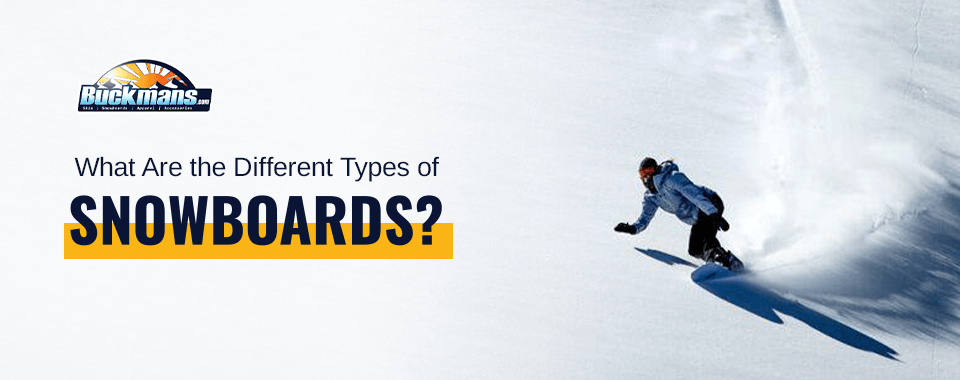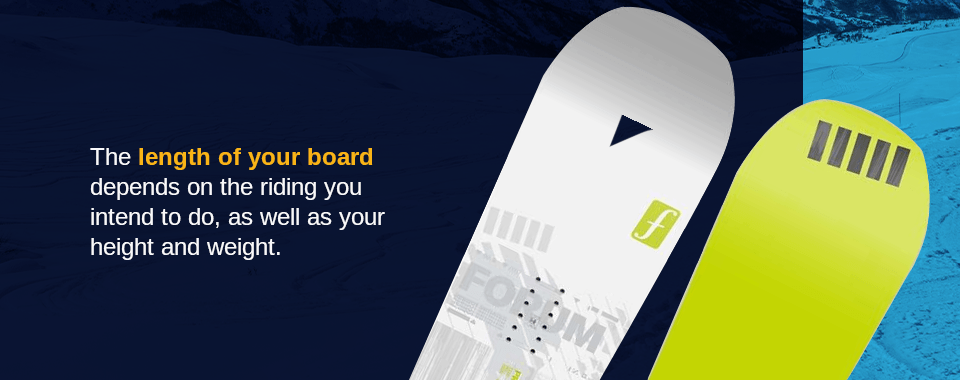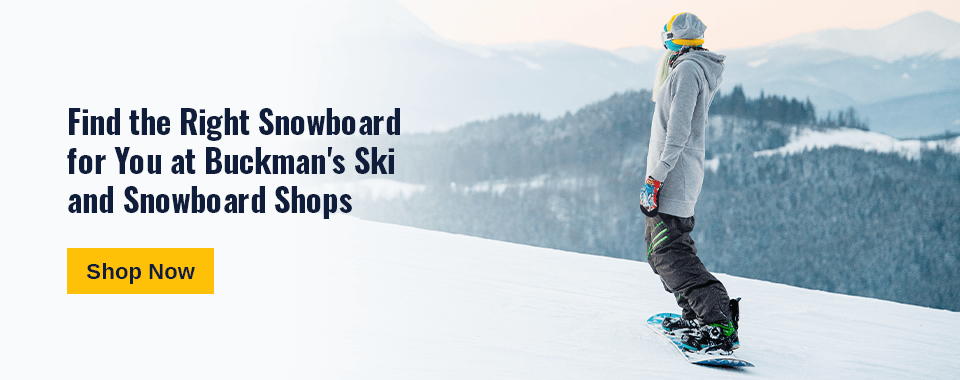 types of snowboards
types of snowboards
What Are the Different Types of Snowboards?
Posted
by
Matt Gahman
on Monday, October 16, 2023
Interested in seeing snowboard styles explained effortlessly? We're breaking down the different types and important factors to help you make the best choice.
What Type of Snowboard Should You Get?
Different snowboard types are designed for unique conditions, skills and purposes. So, let's take a look!
All-Mountain Snowboards
All-mountain snowboards are versatile all-purpose boards that perform well in almost any condition and terrain. These boards are the most popular snowboard for beginners and the first choice of many seasoned snowboarders.
Whether you are a beginner wanting to try out different snowboards before committing to a more specialized board or a pro who enjoys the diversity of a single board, an all-mountain board is an excellent option. It is designed for various parts of the mountain, including groomers, powder and park runs.
Freestyle Snowboards
If you enjoy performing tricks on kickers, jibs, rails, pipes and more, you'll want to get a freestyle snowboard with a shorter design and a true twin shape. Although you could use them to carve around the rest of the resort, limiting them to the terrain park where they are most at home is wisest. They are optimized for this space and unstable at high speeds.
Freestyle boards have specific design elements, such as deeper sidecuts, allowing for tighter turns. They offer easy maneuverability, greater control and better pop for performing tricks, jumps, spins and other creative movements like ride switching.
Powder Snowboards
Powder snowboards are similar to free ride boards, as they also tend to have a setback stance and are directional with a broader nose and tapered narrow tail. However, their shape and the rider's weight positioned further back make them built exclusively for deep snow.
If cruising and floating over the deep snow in backcountry terrain sounds like your ideal day on the mountain, grab a powder snowboard and head to the untouched slopes. Apart from helping with floatation over fresh snow conditions, the board's design, including the generous rocker and position of the binding inserts, also helps with improved steering.
Free Ride Snowboards
Like the powder snowboards, these often feature a directional shape and a setback stance. The purpose of free ride snowboards is speed! Although their primary function is to use the mountain's natural terrain, such as deep snow and backcountry terrain, you can also quickly go to the top of a groomer and head back down as fast as possible.
What makes these boards exciting is that their stiffer and more stable bodies allow you to enjoy high-speed carving with confidence that wouldn't come with other boards. So grab your free ride snowboard and make your way to a variety of terrains, including the groomed slopes and backcountry or go and surf powder.
Splitboards
If you enjoy the challenge of traversing uphill in untouched snowy terrains before riding downhill later, then a specialized and versatile splitboard is just what you need.
These innovative boards transform into a pair of cross-country skis to allow for uphill travel and then reconnect to form a snowboard. You will need to set up your splitboard with splitboard binding that accommodates the skiing and snowboarding modes. You'll also need climbing skins that attach to the base when skinning on your split board, which can be tricky during the uphill climb.
Other Snowboard Features to Consider
Aside from the different types of snowboards, there are other factors to consider before settling on a particular board.

Snowboard Length and Width
The length of your board depends on the riding you intend to do, as well as your height and weight. This table will help you determine the correct snowboard size for you.
The following table can help you determine what type of snowboard you should get in terms of width based on your shoe size.
SNOWBOARD WIDTH CHART |
|---|
SNOWBOARD WIDTH TYPE | BOARD WAIST WIDTH (MM) | MEN'S BOOT SIZE (US) | WOMEN'S BOOT SIZE (US) |
|---|
| Very Narrow | 225-235 | N/A | <6 |
| Narrow | 236-245 | 6-8 | 6-8.5 |
| Regular | 246-255 | 8-9.5 | 8.5-10 |
| Mid-Wide | 256-259 | 9.5-10.5 | 10-12 |
| Wide | 260+ | 10.5+ | N/A |
Snowboard Camber and Rocker
Camber and rocker have to do with the contact points between your board and the snow, depending on the profile style of the board. There are four primary snowboard profiles to explore:
- Camber: This profile offers a responsive, stable ride that provides pop, particularly on hard-packed snow. The board's center point is raised slightly, creating an arch with the nose and tail making initial contact with the snow.
- Rocker: A rocker profile board midsection has an upward concave shape with the tail and nose upturned. These boards offer less spring, have catch-free edges and help riders float, making them popular among beginner riders and powder snowboarders.
- Hybrid: The hybrid option can include camber/rocker, rocker/camber and flat hybrids. For instance, hybrid cambers provide the camber's pop but the rocker's assistance in deeper snow. Conversely, rocker hybrids retain their powder float but offer a better ride at high speeds than regular rockers.
- Flat: A flat profile means maximum contact with the snow but also a slower ride. It offers float, but not as much as rockers, and riders have an increased feel compared to other boards. Flat boards are ideal for beginners, as there is increased stability due to a larger contact area.
Snowboard Shape
The shape of the snowboard has to do with its outline, and different shapes are ideal for different styles and terrains. The most common snowboard shapes are:
- True twin: This shape is symmetrical — if you cut the board down the middle either way, you would have two identical pieces. You can, therefore, use them for switch riding. They are great for beginners, all-mountain riders and snow park enthusiasts.
- Directional: Most directional snowboards are designed to travel in a single direction, typically used for high-speed carving. When shopping boards, you'll notice that many free ride, powder and all-mountain snowboards are directional. The nose is usually softer and longer than the tail to help riders stay afloat and stable.
- Directional twin: Glancing at a directional twin, you might mistake it for a true twin, but it differs in that the nose is longer than the tail, and they have a slight setback stance, notably along the effective edge. This makes the directional twin ideal for various applications, from the park to the groomers.
Snowboard Flex
Snowboards can flex in one of two ways, either along the board's length — called longitudinal flex — or across the width, called torsional flex. Flex ratings typically refer to longitudinal flex.
Most manufacturers categorize their boards' flex from one to 10, as seen here:
- Soft flex is usually 1-3: You'll want a softer flex for beginners, lighter riders and freestyle riders, as these boards are more forgiving and easier to maneuver. They are not suited to high speeds.
- Medium flex is usually 4-6: For all-mountain riders, you'll probably want to choose a board with medium flex. These offer a balance between free-ride stability and freestyle easy turning.
- Stiff flex is usually 7-10: Stiff snowboards are great for veterans, heavier riders, free-riders and backcountry use. These are stable at high speeds but require technique and skill to steer smoothly.
Find the Right Snowboard for You at Buckman's Ski and Snowboard Shops
Whether heading for the backcountry, groomers or snow park, here at Buckman's, we've been supplying the best of the best snowboarding gear to riders since 1971. We are just as passionate about snowboarding as you and understand that only the best will do.
That is why we offer the best deals, including a 100% price match and a diverse range of quality snowboards for you to choose from for all kinds of terrains and riding styles. Pick out your snowboard today and get free shipping on most orders over $50!

Categories:
Snowboard Equipment